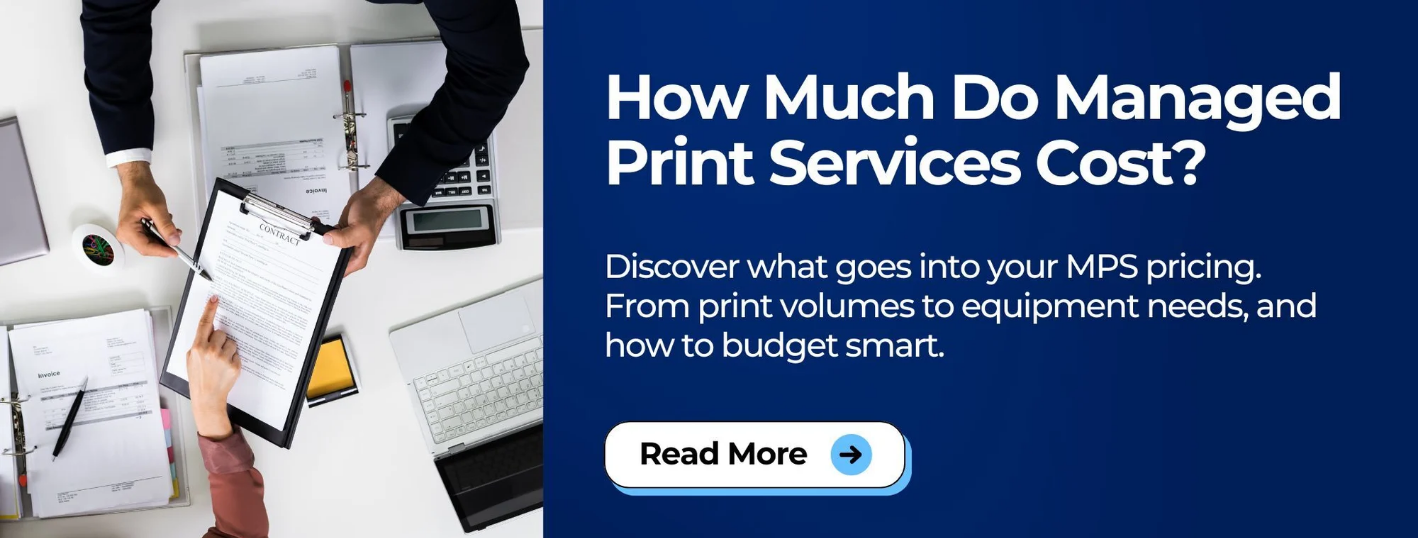
Running a school means managing a thousand things at once. This includes printers. However, keeping them up and running often ends up near the bottom of that list. Whether you're printing lesson plans, testing materials, or administrative paperwork, printing is a major part of school operations. And it can quietly drain your budget and staff time.
At STPT, we've spent over 35 years helping schools regain control over their print environments. Excessive printing costs can add thousands of dollars to a school's monthly expenses, creating chaos with overflowing toner closets, malfunctioning devices, and mounting invoices. That's where Managed Print Services (MPS) comes in as a reliable solution to streamline print management and reduce costs.
This blog explores whether MPS is the right fit for your school. We’ll break down what MPS is, its biggest benefits, its potential drawbacks, and how to decide if it makes sense for your school.
What Are Managed Print Services (MPS)?
MPS is a comprehensive service offered by print vendors to manage your entire printer fleet. Rather than juggling multiple vendors, random supply orders, and surprise repair costs, MPS consolidates everything under one plan.
At STPT, we refer to our MPS offering as eValet. It includes:
- Automatic toner shipments when supplies run low
- On-site service from trained technicians
- Fleet assessments to optimize usage
- Analysis and recommendations to optimize printer fleet
- One simple monthly invoice for all print-related expenses
That said, not every vendor offers the same thing. Some require you to have 15+ network-connected printers to qualify. And, most don’t cover inkjet or non-networked devices. Plus, if you want to track printing behavior and set usage limits, you’ll need to purchase external print management software like PaperCut or Y-Soft.
Want a deep dive into what MPS covers? Check out our MPS definition blog.
Pros of MPS for Schools
1. Better Cost Control & Efficiency
MPS is often brought in to solve one major problem: high, unpredictable printing costs. There are multiple ways in which MPS works to save on your expenses. Here are a few of the main ways in detail:
Auto-toner Shipments
Instead of bulk ordering toner you might never use, MPS tracks supply levels and delivers the right toner to the right device at the right time. No more guessing, stockpiling, or wasting money on cartridges for printers you no longer use.
Reduced Overhead
Staff no longer need to monitor supplies, manage vendor relationships, or process multiple invoices. One school told us they reclaimed 3+ hours a week simply by letting MPS handle supplies and billing. Plus, instead of paying $100+/hour for outside technicians, service is included, saving both time and budget headaches. Learn more about the cost of printer service here.
One Invoice Simplicity
Multiple devices = multiple invoices? Not with MPS. Everything is wrapped into a single, easy-to-read monthly statement. That’s less admin time and fewer headaches for your AP department.
Print Tracking & Limit Setting
In combination with additional tools like Y-Soft SAFEQ or PaperCut, you can track which departments or teachers are printing the most and set monthly print limits. Color print jobs can be restricted, double-sided printing enforced, and unnecessary print jobs deleted from the queue. These help reduce waste and cost.
2. Less Burden on IT Teams
Your IT staff didn’t sign up to be full-time printer technicians. Yet, many school districts report that their tech teams spend 10-15 hours a week managing printer issues.
Standardizing the Fleet
MPS vendors help consolidate your printer models, moving you from a chaotic mix of brands to a streamlined, standardized fleet. That means fewer types of toner, less troubleshooting, and faster training for users.
Asset Optimization
MPS also identifies underused machines and moves your most powerful printers to high-use areas like libraries or computer labs. That ensures your devices match your workflows, helping avoid bottlenecks and reducing downtime.
In-House Technicians
Most MPS providers (including STPT) offer access to in-house, manufacturer-certified technicians. These pros often respond faster than third-party service providers and are trained on the specific devices you use.
Related Read: 6 Ways to Make Your Printing Processes Easier for Your IT Staff.
3. Improved Security & Compliance
Schools are increasingly targeted by cyber threats, and networked printers are a common entry point. In fact, a CyberNews hijacking experiment demonstrated how easy it was to take control of thousands of unsecured printers.
Security Monitoring & Firmware Updates
MPS includes 24/7 device monitoring. It helps keeps firmware updated automatically and optional alerts allow you to spot unusual print activity or potential breaches. Learn about the importance of firmware updates here.
Retiring Risky Devices
Older printers and non-networked devices often lack modern security protocols. MPS identifies and replaces them with secure, compliant alternatives.
Controlled Access
Consolidating your printer management under one provider limits the number of outside vendors with access to your network, reducing risk from third-party vulnerabilities.
Related Read: 4 Ways to Protect Your Printer from Cyberattacks
4. Supports Sustainability Goals
If your school values environmental stewardship, MPS can help.
Toner Recycling
Many providers offer take-back programs for used cartridges, sending them to certified recycling facilities. Learn more about toner recycling here.
Energy Efficiency
Older machines often suck energy even when idle. MPS recommends energy-efficient devices and can enable settings like automatic shutdown during off-hours.
Reduced Paper Waste
MPS can enforce settings like duplex printing and give staff feedback on their usage. The EPA reports that paper makes up 35% of municipal solid waste by weight. MPS helps cut that number significantly.
Want to learn more? Read about Xerox’s sustainability efforts.
Cons of MPS for Schools
1. Print Tracking May Cost Extra
If you want advanced reporting or to limit printing by department or user, you'll likely need to purchase external software like PaperCut or Y-Soft. These tools add cost but also offer more granular control.
2. Staff May Push Back
Some educators or staff members may feel uncomfortable with having their print habits tracked. It's important to communicate clearly that the goal is to reduce waste, not micromanage teachers.
3. Not Every School Qualifies
MPS is best for districts with at least 15+ network-connected devices and relatively high print volumes. If you have just a few devices and low usage, the ROI may not be there.
Want an easy way to view your print setup right now? Download our free print environment tool to get instant insights into your devices, costs, and needs.
Real-World Example: North Texas School District
One district came to us struggling with rising costs and printer chaos. Here’s what happened after implementing eValet, STPT’s version of MPS:
- Reduced printer brands from 8 to 2
- Consolidated 8 separate vendor invoices into one
- Cut unused printers, optimized fleet placement
- IT staff gained back significant time
- Achieved 40% savings in the first year
A few years later, even after a 30% growth in print volume and the addition of 15 new printers, the district was still saving 15%.
Is MPS Right for Your School?
MPS isn’t for every school. But if you:
- Manage 15+ printers
- Struggle with supplies and service coordination
- Have rising print costs or waste
- Want to free up IT time
...then MPS could be a game-changer.
Try Our Free Print Management Tool
Our free print management tool can help you get started. Download it to:
- See every device on your network
- Monitor usage and supplies
- Identify inefficiencies
It’s the first step to discovering if MPS is right for your school.
Want to Know What MPS Might Cost Your School?
If you’ve read this far, chances are you’re seriously considering whether Managed Print Services are the right move. However, one big question probably remains: how much will this actually cost?
We’ve broken it down for you in a straightforward look at what goes into MPS pricing and what your school can expect.

